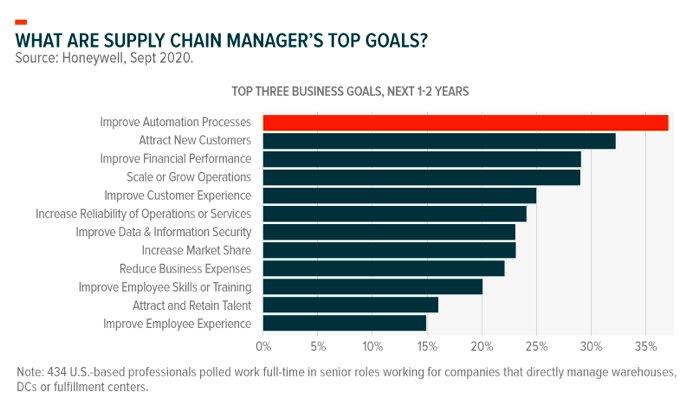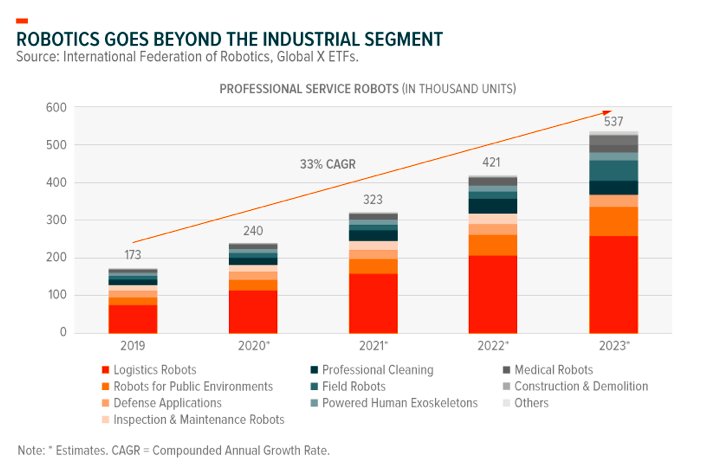By Pedro Palandrani, Research Analyst, Global X ETFs
Severe challenges often accelerate technological advancements. These challenges, like a global pandemic or supply chain disruptions, create incentives to find quick solutions or to change behaviors and processes. 2020, perhaps one of the most challenging years in decades, featured numerous examples of problem-solving with cutting-edge technologies.
The pandemic challenged the economy at large, but sectors such as healthcare, travel, hospitality, and brick-and-mortar retail clearly suffered more. In unison, these sectors faced the daunting task of bringing consumers back to doctor’s offices, planes, stores and other public areas safely. Over the course of the pandemic, businesses increasingly turned to robotics as a viable solution to protect consumers and employees – delivering goods and essentials, disinfecting high-touch areas, or providing concierge-like services – to limit human-to-human interactions.
As a result of robots becoming more commonplace in customer-facing roles, the perception about robots is beginning to change. Rather than having the stigma of being job-takers, they are instead increasingly seen as human-enhancers and protectors. Eventually, we expect they will become viewed as indispensable parts of our daily lives.
Robotics Seen in a New Light
In early 2020, we looked at how supply chain constraints are accelerating robotics adoption. Amid rising geopolitical tensions and pandemic-related supply chain issues, robots offer manufacturers more resilient production. Rather than depending on a global trade system, re-shored manufacturing with heavy use of automation can potentially reduce costs, improve reliability, and allow for more flexibility. Recent studies indicate that a top goal of supply chain managers in the next couple of years is to improve their automation processes.

Yet robotics goes beyond the industrial segment today, with penetration increasing in multiple segments. In fact, professional service robots in areas such as logistics, cleaning, medical, inspection, maintenance, and others are expected to grow to 240,000 units by the end of 2020, up 38% from 2019.1 These robots can complete tasks considered dull, dirty, dangerous, and/or delicate.2
As a result, robots are becoming less controversial as far as job concerns go. Before the pandemic, some workers and unions were concerned about potential job losses as a result of automation. But those concerns are easing somewhat as robots help to keep workers safe by reducing worker interactions and increasing social distancing.

Robotics in Retail & Logistics
Disruption in the retail industry was already well underway prior to the pandemic, with e-commerce rapidly gaining market share versus brick-and-mortar stores driven by competitive pricing and positive user experiences. Now, with e-commerce reaching broader audiences than ever before, the need for same-day and next-day deliveries has warehouse and fulfillment center operators looking to increase their automation capabilities even more. On their wish list are more autonomous capabilities through vehicles and delivery robots. In 2020, logistics robots could increase 52% to 114,000, up from 75,000 in 2019.3 By 2023, these robots could number 259,000.4
Warehouse Automation: E-commerce’s rapid growth creates a need to transport goods efficiently within warehouses, before they even get on the road to the consumer. Brick-and-mortar stores require greater handling of goods in bulk, while online purchases require granular efforts, including picking, packing, and shipping. Today, order picking remains the most common use of robotics in warehouses.5 Essentially, picking is the process of identifying the location of an item in the inventory of a warehouse and sending it to the packing station. Before robots, people had to walk through hundreds of aisles, find the item, and bring it back to the packing station. Robotics picking, instead, uses mobile robots to transport items to humans. In most cases, human personnel just need to grab the item delivered by robots and place it in conveyor belts directed to the packing station. Robotics implementation in warehouses can increase pick rates by as much as 252%, allowing operators to fulfill 15% more orders than without robotics solutions.6
Autonomous Delivery Vehicles: While autonomous passenger vehicles may take a few more years to improve and gain regulatory approvals, e-commerce companies don’t face the same hurdles as they move goods, not people. These companies are leveraging autonomous vehicle technology to accelerate online delivery times and reduce costs. For example, JD.com, China’s second largest e-commerce company, has 100 autonomous robots loaded with consumer packages making deliveries. The robot navigates a given route and then messages recipients with a verification code so that they can pick up their packages.7 Just one of these robots delivered 13,000 packages during a 107-day deployment in Wuhan, the epicenter of the pandemic.8
Robotics in Hospitality & Travel
As two of the sectors hit the hardest by the pandemic, the hospitality and travel segments are reconsidering ways to improve their experiences, productivity, and job satisfaction. And robots can help them. Robots for public environments are still in the very early stages of adoption, totaling roughly 28,000 in 2020, up 40% from 2019.9 But estimates are that the segment could grow to 76,000 units by 2023.10
Room Service Robots: Autonomous room service robots can be a cost-effective way to improve operations and offer greater customer service. Hotels can use them to deliver food, beverages, and other amenities to a guest’s door. The robots can manage elevators and hallways, while navigating crowds. In the process, the robots alleviate time-consuming tasks for workers and promote greater guest satisfaction. Some apartment buildings now use these robots too, offering residents secure delivery right to their door.
Robotic Waiters: The pandemic has hit the restaurant industry particularly hard. To increase safety of workers and diners, robotic waiters are helping teams increase their efficiency by carrying dishes from kitchen to table, and vice versa.
Robotics in Healthcare
Robotics solutions in healthcare have historically focused on big-ticket activities like surgery. But in 2020 robots became critical to cleaning, sterilization, and, in some cases, even food prep processes in medical facilities. In a post-pandemic world, greater robotics adoption is inevitable in healthcare with nursing, serving, cleaning, surgical, and rehabilitation robots representing just a few of the many potential use cases.
In 2020, unit sales of medical robotics for professional use could total 12,000, up 33% from 9,000 at the end of 2019.11 The number is expected to more than double by 2023, reaching 26,000 units.12
Disinfecting & Cleaning Robots: Some cleaning robots can clean floors in half the time compared to manual efforts.13 These robots won’t replace sanitation workers. Rather, they’re expected to enhance worker productivity and take care of dull tasks. This robotics application doesn’t only apply to the healthcare industry. Autonomous floor scrubbers are helping retailers like Walmart clean their stores. To date, Walmart has nearly 1,800 units at their locations across the U.S.14
Robotic Surgery: Research shows that robotic surgery is associated with improved clinical outcomes for patients. Lower costs, reduced postoperative recovery time, and fewer complications are just a few benefits. Recent clinical data from Michigan shows that the use of robotic surgery increased from 1.8% in 2012 to 15.1% in 2018.15 While procedures such as inguinal hernia repair have high robotic penetration rates (28.8%) other procedures like complex cancer resections still have very low penetration rates (3.9%.)16 As non-emergent surgical procedures resume after the pandemic, surgical services availability could become scarce, making surgical robots more important than ever.
Nursing Robots: Robotic nurses can take a patient’s vital signs and even help patients get up and move around. Some nursing robots even have monitors that enable video communications, which can help patients stay in touch with their doctors or even their families. In Japan, a country with the highest percentage of 75+ individuals out of any OECD country, these robots are helping fill the gap in the healthcare workforce.
Conclusion
Amid the pandemic, many high-touch segments of the economy become high tech-oriented. The seamless application of technological tools to support day-to-day operations in a safer and more efficient way is now entering many segments of our economy. Whether to avoid costly supply chain interruptions, support e-commerce’s growth, reinvigorate hospitality services, or support healthcare demand in a post-pandemic world, the successful implementation of robotics is paramount for a successful re-opening economy.
Photo Credit: Huw Gwilliam via Flickr Creative Commons
FOOTNOTES
1. IFR, “World Robotics Report 2020,” Sep 24, 2020.
2. Ibid.
3. IFR, (n1)
4. IFR, (n1)
5. 6 River Systems, “What is warehouse robotics?,” Aug 28, 2020.
6. 6 River Systems, “The Business Case For Collaborative Robots,” accessed on Dec 16, 2020.
7. JD.com, “JD announces world’s first level-4 autonomous delivery vehicle application at scale,” Oct 22, 2020.
8. Ibid.
9. IFR, (n1)
10. IFR, (n1)
11. IFR, (n1)
12. IFR, (n1)
13. Softbank Robotics, “Cleaning Protocols Remain Essential Despite COVID-19 Vaccine,” Dec1, 2020.
14. CNN, “Walmart is doubling down on robot janitors. Here’s why,” Apr 9, 2019.
15. Kyle Sheetz, et al. , “Trends in the Adoption of Robotic Surgery for Common Surgical Procedures,” Jan 10, 2020.
16. Ibid.



